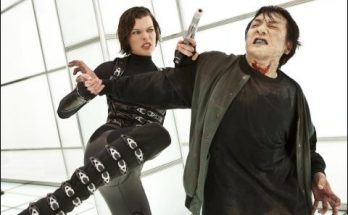In the film, De Palma keeps images of the Dahlia in the background until the very end, purposefully holding his camera off of close-ups of the body and building the audience’s morbid curiosity and anticipation for what the deceased Betty looks like. He, instead, introduces us to Betty—very much alive—through on-screen camera tests. De Palma continues, “It was as if someone was displaying a grotesque work of art, then saying, ‘look what I’ve done.’ Those pictures make you think someone was sculpting in flesh. They just seep into your subconscious. My concept was to hold that image back until the end of the film.”
Producer Linson states, “Brian sees the sequences of things visually, and the dialogue is the icing. He brings in the backstory of the Dahlia through screen tests, and he has his own cameo (à la Hitchcock) in there.”
The voice of the off-screen filmmaker who is trying to direct Betty during her test is actually De Palma, originally done as a temporary track, but kept once the production team noted how well Kirshner and the director sparred. De Palma notes, “What you see with Mia during her screen tests was very much ad-libbed. We explored the relationship of my playing a callous, insensitive producer, and Mia, a delusional star-struck, desperate girl. We did a whole series of things on camera, then Vilmos put it into black-and-white. This makes Elizabeth Short a real human being and made the movie much more emotional.”
Continuous takes with the audience-as-participant, another mark of the director, would also be used in The Black Dahlia. The first time the audience is allowed into the Linscott mansion, Swank plays right into the camera in a first-person shoot as we are welcomed in as her date, Bucky. “It’s an old convention of the war,” says De Palma. “This was the place to do it. Let her play her nuttiness right to camera and suck in the audience.” Equally as jarring, as soon as Bucky/audience member sits at the dinner table, the camera switches back to a third-person shot.
It was always De Palma’s intention to use Ellroy’s lines in this scene, noting, “I directed it underlining his intention. This is the craziest dinner one could ever be at, but everybody seems to think everything’s quaint, the way things should be. Only later do we see the deadly consequences of this Addams Family. But when we’re introduced to them, it’s like a Restoration comedy.”
Ground-level camera angles would be used, allowing the audience to look straight from the corpse’s perspective into Bucky’s face when Detective Millard calls him over to view the Dahlia’s body. Switched up again, the audience is Bucky when D.A. Loew dresses down the detective when he’s sitting at his desk.
De Palma and Zsigmond’s choices draw us in even further into Betty’s world, pre- and post-mortem. The complicated camera work needed to follow the fight between Mr. Fire and Mr. Ice would prove not only a physical challenge for Hartnett and Eckhart, but one for cinematographer Zsigmond. As Bucky throws the fight, dropping his right and taking a left hook from Lee—followed by a fast right uppercut that takes out his two front teeth—the camera and choreography work blend beautifully. In this scene and others, De Palma would make much use of his signature split-screen and split-diopter shots.
“In an anamorphic (traditional lens) movie, you see a big face in the foreground and someone 30 feet away, then both of them out of focus,” notes cinematographer Zsigmond. “Optically, it’s impossible to make both clear, so we use a split diopter lens that hides the split and makes the image seamless.” This is also a trademark De Palma imprint, used in films like The Untouchables, Blow Out and Carrie.
Finally, for the Dahlia herself, the production team decided to save sharing the visuals of her body bisected, lying in the lot that would become Leimert Park, until the end of the film. De Palma notes, “We discovered we had to create a living image of the Dahlia. All of the images of her are her dead outside or on an autopsy table. It was a very close replica of the body, and I was always shooting away from it. We only really brought it out in all its glory in the last scene on the lawn.
For audience and filmmaker alike, “the images of her are the things that keep her alive in our imaginations, dreams and nightmares,” he says. “Bucky will always be haunted with this image, much like in my other films where something subconscious grabs you—like Carrie grabbing you from the grave.”
Next Page: Re-Creating Hollywoodland
Views: 50



